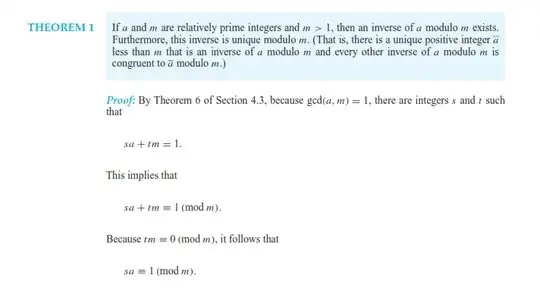Though you can prove this by unwinding the definitions to reduce it to a divisibility result, this is not the best way to proceed conceptually. In order to become proficient at modular arithmetic it is essential to learn how to manipulate these generalized equations (congruences) the same way you manipulate ordinary integer equations, using the same equational logic and arithmetical laws.
Let's examine very carefully how to make that inference from this viewpoint. Below, all congruence are mod $\,m,\,$ i.e. I omit the trailing $\!\pmod m.$
First, $\ \ \ \color{#c00}{m\equiv 0}\ \Rightarrow\ t\color{#c00}m\,\equiv\, t\cdot \color{#c00}0\,\equiv\, 0\ $ by the $ $ Congruence Product Rule.
Next, $\ \color{#0a0}{tm\equiv 0}\,\Rightarrow\, 1\,\equiv\, sa+\color{#0a0}{tm}\,\equiv\, sa +\color{#0a0}0\equiv\, sa\ $ by the $ $ Congruence Sum Rule.
The Sum and Product Rules say that we can replace arguments of sums and products by any congruent argument (necessary for these operations to be well-defined on the congruence classes). This is the congruence analog of "replacing equals by equals" in ordinary integer equational reasoning. Thinking of a congruence $\,a\equiv b\,$ as a generalized equality $\,a=b,\,$ allows us to reuse all of our well-practiced skills manipulating ordinary integer equations, e.g. $\, a^2\!-b^2\equiv (a-b)(a+b)\,$ is true also for congruences because the proof uses only basic arithmetical laws (distributive, commutative, etc), all of which remain true also for congruences (this will become clearer when one studies modular arithmetic in general rings, i.e. quotient/residue rings)
It is important to also be aware of how congruence arithmetic differs from ordinary integer arithmetic, so one doesn't carry the analogy too far. For example, for ordinary integers we have $\, j,k\ne 0\,\Rightarrow\, jk\ne 0,\,$ bt this may fail modularly, e.g. $\,2,3\not\equiv 0\,$ but $\,2\cdot 3\equiv 0\pmod 6.\,$ In fact, that property holds true modulo $\,m\,$ iff $\,m\,$ is prime - a fact which proves fundamental.

